A mitre saw allows you to make different types of cuts easily, quickly and accurately.
It’s easier to use than a circular saw especially for a beginner. You can make angled cuts more accurately with a mitre saw.
Whether you are just starting out in woodworking or are looking to add another tool to your workshop, a mitre saw is a great choice.
It’s a bit more expensive than a circular saw but it will greatly improve the quality of your work and save you time cutting lumber.
To help you find the best mitre saw for your needs, we extensively researched and compared dozens of models.
We picked five that we believe are the best for different types of woodworkers in the UK, from hobbyists to pros.
Here are the factors we considered when picking the top rated mitre saws. Keep them in mind when choosing the best mitre saw for your needs.
Key Considerations When Choosing a Mitre Saw
a) Type of Mitre Saw
There are three types of mitre saws.
- A basic mitre saw can make two types of cuts: a straight cut or crosscut like a normal saw and a mitre cut. Most mitre saws can cut to an angle of up to 45 degrees.
- A compound mitre saw can make four types of cuts: a crosscut, a mitre cut, a bevel cut and a compound mitre and bevel cut. This is the best type of mitre saw for most people.
- A sliding mitre saw can slide along an arm to cut a wider piece of wood such as a floorboard. While they offer more versatility, sliding mitre saws are heavier and less portable.
b) Blade
The first thing to check regarding the blade is its size. Common blade sizes are 8”, 10” and 12”.
Most mitre saws come with a 10” blade that is adequate for most woodworking projects.
Also check what kind of materials the blade can cut. All blades can cut wood. Others can also cut through plastic, laminated panels and even metal.
Don’t forget to check the blades cutting capacity in terms of maximum cutting angle and cutting width and depth.
c) Motor Power
This is not that important for hobbyists and home projects. Any decent mitre saw will easily cut through any piece of wood.
More motor power translates into higher RPM, which in turn allows you to cut through lumber faster.
Motor power for mitre saws typically starts at 1,500 watts. That delivers about 4,200 rpm. A 1,600, 1,800 or 2,000 motor will often have higher rpm.
d) Weight
A lighter tool is easier to handle. It’s especially useful if you move the mitre saw around your workshop often or from one project site to another.
The heaviest mitre saws weigh around 17-20kg. Though harder to lift, they often provide more power and extra features.
The weight is not an issue if you are planning to set it up at a permanent station.
The lightest mitre saws weigh around 6-8kg but they often lack in power and extra features. These are great if you want something basic and portable.
e) Laser Guidance
With a basic mitre saw, you have to align the blade with your cutting line before you cut. If you want more accuracy, get a mitre saw with a laser.
Laser guidance shows you exactly where on the wood the blade is going to cut. You can easily align the blade with the cut line without having to bring the blade down first.
f) Dust Collection/Extraction
Sawing generates a lot of dust. Check whether the saw has any sort of dust management system.
Cheaper mitre saws use a simply dust bag where dust collects as you work. Pricier saws have a more complicated dust extraction system that vacuums the dust away to keep the work area clean.
g) Extension Bars
Check if the mitre saw comes with extension bars that work as a stand. They make it easier to cut long and heavy pieces of wood.
If the saw doesn’t have extension bars, consider buying a mitre saw stand.
h) Corded vs. Cordless
If you want added portability or your work area doesn’t have an outlet, consider buying a cordless mitre saw.
But be warned; they gobble up battery charge fast since they use a lot of power. Get extra battery packs to extend your work time.
How to use a Mitre Saw
The most important bit when using a mitre saw is safety. Put on a pair of safety glasses and hearing protection.
Get familiar with all the safety features of the saw including the locking mechanism, the finger trigger and the blade guard.
Before you start, make sure the mitre saw is on a sturdy surface. This can be the floor, a stable worktable or a mitre saw stand.
When using the saw, make sure your fingers stay at least 6” away from the spinning blade. Hold the handle steadily as the blade cuts through wood and wait until the blade has stopped before lifting it back up.
Unplug the saw when it’s not in use or when you want to change or clean the blade.
Making cuts
Making cuts using a mitre saw is fairly easy though you’ll need a bit of practice to get it right.
Use the mitre scale to set the angle of the cut. Set the scale to 0 if you want a crosscut.
If you want to make a bevel cut, set the bevel scale to the required angle and the mitre angle to 0. If it is a compound cut, set both the bevel and mitre scales to the required angles.
Lower the blade (while it’s off) and align it slightly beyond your marked cut line on the waste side. This ensures you get the exact length of wood you want.
Lift the blade and get ready to cut.
Hold the piece of wood firmly or use a clamp to keep it from shifting.
Press the finger trigger and wait for the blade to get up to speed. The mitre saw may jerk as the blade starts up. Don’t worry; that’s normal.
When the blade is at maximum speed (you’ll hear), lower it gently and cut through the wood.
The Best Mitre Saw Reviews
1. Makita MLS100 240 V 255 mm Electric Saw
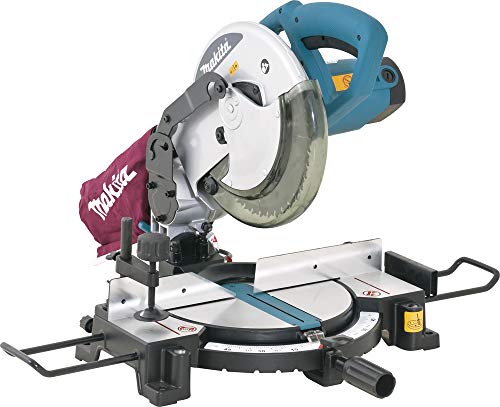
The Makita mitre saw is an excellent choice for beginners and hobbyists who are looking for something affordable, versatile and easy to use.
The mitre saw comes with a 255mm (10”) diameter with a maximum mitre angle of 45 degrees on both sides.
It can also make a single bevel cut of up to 45 degrees.
That’s enough flexibility for most home projects.
The see through blade guard makes it easier to see where you are cutting to ensure accuracy. It’s not as good as a laser guidance system but it will do for most people’s needs.
The 1,500W motor spins the blade at 4200 rpm, fast enough to cut through tough and thick pieces of wood.
If you are dealing with long pieces, extension wings on the side provide added support.
A dust bag keeps your workspace neat and improves visibility when you are cutting.
What I like about it:
- Well-built and sturdy – works reliable for years.
- Versatile design makes it possible to make cross, bevel, mitre and compound cuts.
- Includes a dust collection bag.
- Electric brake for maximum safety.
2. Bosch Professional GCM 8 SJL Corded 240 V Sliding Mitre Saw
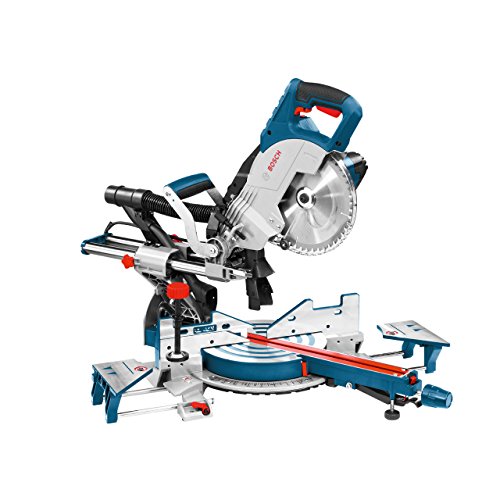
If you regularly cut wide pieces of wood, turning the pieces over to complete the cut is tedious and time-consuming.
The Bosch Professional sliding mitre saw will save you loads of time. You can cut as wide as 312mm in one go.
This is especially helpful for wide floorboards and laminate panels.
The saw can also make mitre and bevel cuts.
The mitre angle range is wider than in most mitre saws. It ranges between 52 degrees on the left and 60 degrees on the right.
For bevel cuts, you get a range between 47 degrees and 2 degrees.
This is one of the most accurate mitre saws. It uses laser to guide the blade. You can easily see where it’s going to cut before you lower the blade.
To keep your work place clean, an advanced dust extraction system vacuums up dust at two points.
What I like about it:
- Powerful 1,600W motor spins the blade at 5,500 rpm for added cutting power.
- Easily handles wide pieces of wood such as floorboards and laminates.
- Versatile cutting angles.
- Efficient dust extraction keeps work area clean and visible.
- Accurate laser guidance.
3. Einhell UK TC-MS 2112 1600 W Compound Mitre Saw
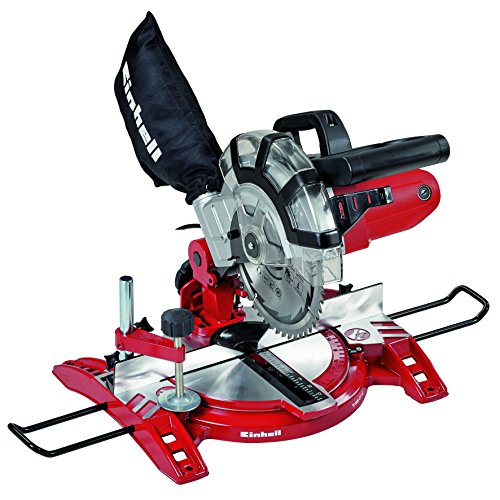
If you are looking for a budget mitre saw, this one by Einhell is a good choice. It costs half the price of some premium mitre saws but provides comparable cutting performance.
Note: The product description on Amazon says the box contain a Sliding Mitre Saw. But this is not a sliding mitre saw. The only parts that slide are the timber rests on the sides.
This is a compound mitre saw.
It can make mitre cuts from 45 degrees on one side to 45 degrees on the other. Bevel cuts are more limited; it can only cut 45 degrees on one side.
The horizontal and vertical cutting limits are also a bit limited compared to other mitre saws. But most home users won’t be constrained by the limits.
The motor is impressively powerful. It puts out 1600W, enough to spin the blade at 5000 rpm. The blade makes easy work of even the toughest pieces of wood.
One thing you’ll love about the Einhell saw is how light it is. This makes it easy to handle and move it about.
What I like about it:
- Easy to set scale.
- Clamping device keeps lumber stable and ensures accurate cuts.
- Can saw wood, laminated panels and plastics.
- Dust bag makes for a cleaner work area.
4. VonHaus 2000W Sliding Compound Single Bevel Mitre Saw
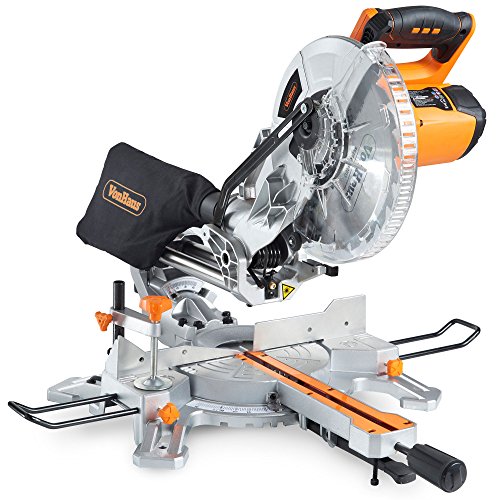
If you want a sliding mitre saw but think the Bosch one is a bit too pricey, the VonHaus mitre saw is a great alternative.
For less than half the cost of the Bosch saw, you get versatile cutting angle with laser guidance for accuracy.
The saw’s 10” (255mm) blade cuts easily through any type of wood as well as plastics.
It’s powered by a 2,000W motor, which is actually more powerful than the Bosch motor.
Where the VonHaus falls behind is in cutting versatility. It provides only single bevel cut of 45 degrees.
For mitre cuts however, it can cut in both directions at a maximum angle of 45 degrees.
The built-in laser makes it much easier for beginners to make an accurate cut. The wood clamp also helps with accuracy.
For those times when you are cutting large pieces of wood, use the side support bars to keep the piece stable.
What I like about it:
- Affordable considering it’s a sliding mitre saw with laser and a 2,000W motor.
- Side support bars.
- Includes dust bag.
- Accurate cutting thanks to the laser and clamp.
5. Dewalt DWS774-GB 216-mm 230V Slide Mitre Saw
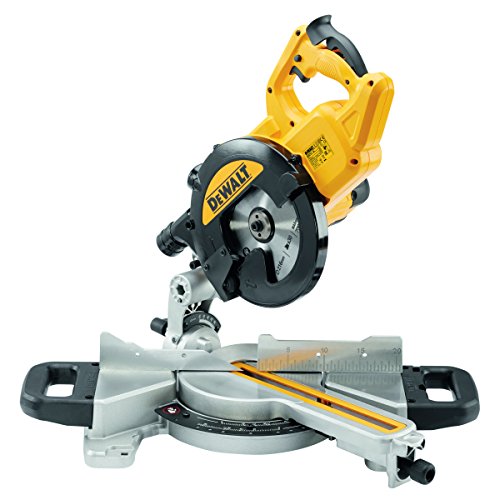
This is another good option if you are looking for a sliding mitre saw. It’s a bit more expensive than the VonHaus saw but still costs less than the Bosch sliding mitre saw.
The 216mm (8.5”) blade can cut to a depth of 70mm and a width of 250mm (at 90 degrees).
It is a single-bevel mitre saw, with a maximum angle of 45 degrees. But for mitre cuts, you can set it to cut in either direction to a maximum of 45 degrees.
The Dewalt saw doesn’t have a laser. Instead, it uses Dewalt’s XPS Shadow Line.
This works by shining LED lights onto the blade, creating a shadow line on the wood to indicate where the blade will cut.
The main advantage of XPS Shadow Line over laser is that you can see the thickness of the blade. This is helpful for projects that require millimetre level accuracy.
That said, we only recommend the Dewalt DWS774-GB for DIYers and home projects.
The 1,400W motor is may feel a bit underpowered for certain types of wood. We also wish the saw blade came with more teeth. The 30 teeth count is not ideal for things like plywood and panels that need a fine cut.
But overall, the Dewalt mitre saw is a solid choice for hobbyists and beginners looking for a good quality and easy to use sliding mitre saw.
What I like about it:
- Can cut longer widths compared to fixed mitre saws.
- XPS shadow line ensures accurate cuts.
- Efficient dust extraction.
- Easy to use.
Frequently Asked Questions
What are the main tips for using a mitre saw?
- Safety first – ensure the mitre saw is properly secured, either bolted to a stable surface or clamped onto a stand. Always wear safety goggles and ear defenders, and avoid loose clothing that might get trapped in the blade.
- Measure and mark your board where you want to cut it, so that you are prepared before you start and don’t make any mistakes.
- Place the board onto the saw, flush against the back of the saw’s base.
- Loosen the mitre gauge, and move the blade to the desired angle.
- Re tighten the mitre gauge, and lower the handle to where the blade is in contact with the wood.
- Make any small adjustments to the wood before you make the final cut, then clamp the board firmly into place so it doesn’t slip.
- Raise the handle, press the starting button and allow the motor to power up.
- Lower the handle carefully, until the blade has passed through the wood.
- Release the trigger when the board has been completely cut, and allow the blade to fully stop rotating before you raise the handle.
How to cut skirting boards with a mitre saw?
First of all, you will need to measure and mark out your timber, ensuring that you check a few times. Remember the old adage “measure twice, cut once”! Make sure you do your measuring and marking on a flat, stable surface.
Next, set the correct angle on your mitre saw (these are usually 45 degrees for a skirting board, but if you have other measurements you can set these too). Position your board on the flat surface of the mitre saw and push it up flush with the fence, then move it until the cutting point is directly over the blade recess. Ensure you are wearing safety gear (goggles and ear defenders), and make sure you have no loose clothing that could get caught in the saw.
Press the power switch to start up the saw, press the handle release, then carefully lower the cutting blade down to the board. Hold on tightly to the board you are cutting with your other hand, so there is no danger of it slipping and messing up the cut.
Repeat the process for the other parts of your skirting board, and you should be left with perfectly formed mitre joints that can finish off your job.
How to cut cornice with a mitre saw?
One of the best tips is to buy an extra length of cornice in case of mistakes, as using a mitre saw to cut cornice can be a tricky business! Luckily, a mitre saw is designed for cutting mitred corners, even in material that is not as straight and simple as a piece of wood.
Rest the back of the cornice against the back of the mitre saw’s guide, and adjust the angle until you have the desired angled for cutting. A mitre saw should give you really good, accurate results every time, so just make sure you spend a bit of time setting up the right angle that you want, so you don’t end up having to cut twice or waste materials.



